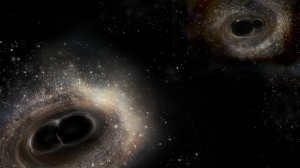“Nature” – the prestigious magazine has published an article on the evolution of two 40-100 Msun stars which were the source of the gravitational waves.
In 2016 scientists from LIGO Scientific Collaboration (LSC) and Virgo Collaboration announced the discovery of the gravitational waves. In September 2015 two detectors of Laser Interferometer Gravitational-Wave Observatory (LIGO) detected gravitational waves, which were produced during the final fraction of a second of the merger of two black holes to produce a single, more massive spinning black hole. In December LIGO detectors observed gravitational waves for the second time.
Although we found out about the gravitational waves in 2016, six years ago the Polish-American scientific team led by Prof. Krzysztof Belczyński from the UW, predicted that the collision of two massive black holes would be the first source of the gravitational waves.
Currently, these researchers claim that the detections of gravitational waves will be more common very soon. Prof. Belczyński explains that we could observe from several dozens to several hundred detections each year when LIGO reaches its full sensitivity around 2019-2020.
The UW researcher and colleagues modelled how binary star systems could evolve into binary black holes like the source of GW150914, the first LIGO signal. They calculated that the black holes that gave rise to GW150914 were previously very massive stars (40 to 100 times the mass of the Sun) that collapsed to form binary black holes that subsequently merged. These stars were formed 2 billion years after the Big Bang.
By these models we could better understand the evolution of stars. Simulations were done by scientists from the Astronomical Observatory of the UW, students of astronomy Grzegorz Wiktorowicz, Wojciech Gładysz and a computer scientist – Krzysztof Piszczek.
„The first gravitational-wave source from the isolated evolution of two 40-100 Msun stars” it is a title of the article in the “Nature” magazine. Among authors are Prof. Krzysztof Belczyński and Prof. Tomasz Bulik from the University of Warsaw and two American researchers Daniel Holz from the Univesity of Chicago and Prof. Richard O’Shaughnessy from Rochester Institute of Technology.



